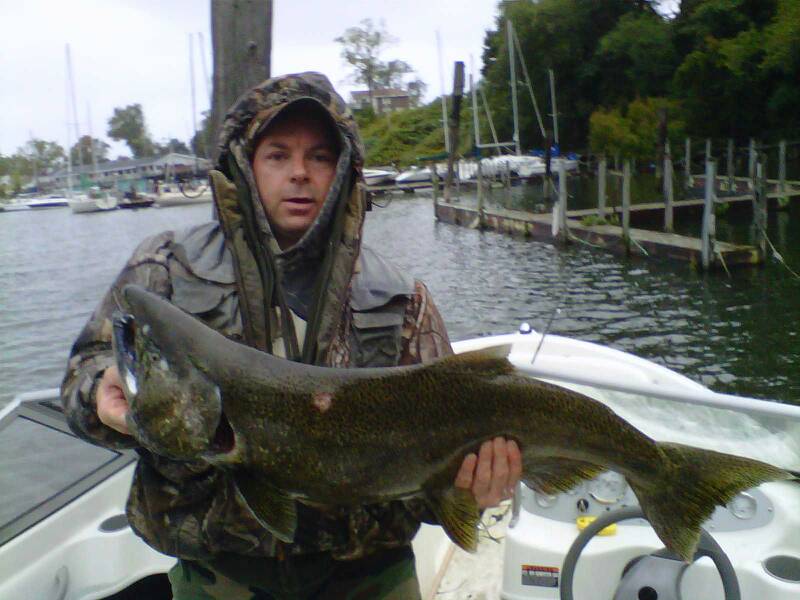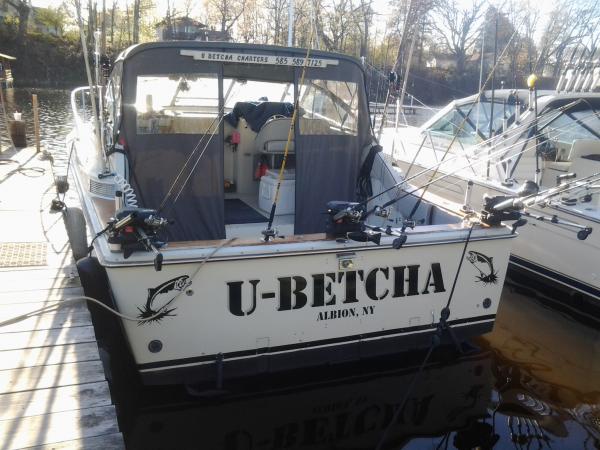

Matthew
Members-
Posts
136 -
Joined
-
Last visited
Content Type
Profiles
Forums
Events
Gallery
Store
Everything posted by Matthew
-
The diver is not fixed to the line but is attached at any position.
-
We've been running long leads with regular divers for years. Just add two church clips on your diver and your done. Last year we were down 200 feet with our divers and running a 50 foot lead between our diver and flasher, no hand lining involved with church clips
-

smart troll vs fish hawk
Matthew replied to Hooked on Kings's topic in Questions About Trout & Salmon Trolling?
I have used all speed and temp units. Fishhawk is a great unit for downrigger down speed, temperature and depth. If you want down temp and depth on your lures then Smart Troll is the way to go. -

Tieing mono to wire ?
Matthew replied to fisherman 57's topic in Questions About Trout & Salmon Trolling?
Agree 100%, We also find not to use too small of a swivel, thin wire in the swivel will cut through the mono. -

Wire Diver numbers verified with Smart Troll
Matthew replied to Matthew's topic in Open Lake Discussion
Currents play a huge role in how deep gear goes, by testing in a no current situation it gives us a starting point for future reference. -
-

Wire Diver numbers verified with Smart Troll
Matthew replied to Matthew's topic in Open Lake Discussion
These tests they were on Lake O in 400 FOW with no current. This same setup in 4 directions and the results were the same. A bow mount electric motor was used to fine tune the speed because it is very important to have the exact same speed with no variance, bags were deployed. Tests were done on a calm day. Marked the wire in 100 foot measured intervals from a spooling machine. The diver did not have a ring and was a #1 or 107mm equivilant. Divers were run with a 4 inch spoon. Running a dodger then the depth will be far less. As an example, once we were running a rig on one side of the boat with a mag diver plus spoon and it was running 81 feet down, on the other side of the boat the exact same setup with a flasher and it was 56 feet down. Both had the exact same amount of measured line out. 30lb power pro and 30lb wire reach the exact same depth with a diver, 50lb power pro does not achieve even close to the same depth. Any variance in speed or direction can cause dramatically different results. These are numbers have been recorded using very regimented tests. -

Wire Diver numbers verified with Smart Troll
Matthew replied to Matthew's topic in Open Lake Discussion
I will run that tomorrow -

Wire Diver numbers verified with Smart Troll
Matthew replied to Matthew's topic in Open Lake Discussion
we ran both 7 and 19 strand and numbers were the same -
We have done some tests with #1 (107mm)wire divers on #3 settings and here are the results. Wire Diver 2mph 2.2mph 2.5mph 3mph #3 setting depth depth depth depth 100' line out 36 34 32 28 200' line out 56 54 53 49 300' line out 60 58 57 53 100' line out, 2mph depth 36', 2.2mph depth 34' 2.5mph depth 32' 3mph depth 28' 200' line out 2mph depth 56', 2.2mph depth 54' 2.5mph depth 53' 3mph depth 49' 300' line out 2mph depth 60' 2.2mph depth 58' 2.5mph depth 57' 3mph depth 53' All depths were verified with Smart troll that shows live feedback of depth and temp at the lure.
-
We have done some tests with wire divers on #3 settings and here are the results. Wire Diver 2mph 2.2mph 2.5mph 3mph #3 setting depth depth depth depth 100' line out 36 34 32 28 200' line out 56 54 53 49 300' line out 60 58 57 53
-
After collecting alot of data from our customers, we had found that 50% have great success with the Torpedo Speed and Temperature cable and 50% could not get it to work. After further investigation, it was discovered that the successful customers did not crimp the cable when initially attaching the cable to the downrigger spool while the other 50% did crimp. Excessive force when crimping the cable causes the stainless steel to compromise the nylon coating surrounding the copper wire and the stainless wire to come in contact with the copper wire, causing a short. All packaging now states not to crimp the Torpedo Speed and Temp cable at any juncture. Thank you for your assistance. Matthew
-
Make sure you don't crimp the cable when attaching to the downrigger spool. This causes 95% of all failures.
-
We ran the smart troll probe on Copper and it didn't move at all once it was at trolling depth, dipsies and torpedo's moved alot but leadcore and copper stayed at the same depth
-
Stan what type of action do you think copper has?
-
The 19 strand today is not like the 19 strand years ago. Today's 19 strand can be used with all reels without issue.
-
I would agree that 7 strand will wear the guides but we have been using the 19 strand on the same rods for 5 years now on cheap guides with no wear evident.
-
I would say the fishhawks and smart troll units are the only ones that don't need coated cable
-
300 feet of 19 strand is $15 so it seems to be in the same price range. The main two differences I see is, wire is more fun to reel in, second you can fit 33 colors on a tekota 600 reel.
-
The way we run it is we put a small swivel on the backing and attach the 19 strand to it, then on the business side we attach another swivel and attach the florocarbon. Run it just like you would leadcore so you attach it to a board. If you feel that the sink rate for leadcore is 40' with 300 feet of leadcore out then the 19 strand will reach the same depth, Basically you run it the same way you run copper. Can attach the 19 strand to the board or can attach the backing to it. We have been using 19 strand for years on our downrigger rod and we attach it to pinch pads with no issues.
-
As many tournament fisherman have discovered recently Torpedo 19 strand stainless steel wire has the same sink rate as leadcore. 300 feet of Torpedo 19 strand wire and 10 colors of leadcore will sink to the same depth. What is nice about the 19 strand wire in this application is there is no need for a special rod, don't need roller guides or a twili tip.
-
In support of our tournament teams, all KOTL Pro and Am teams are invited to spool up one empty wire reel for free at the Torpedo Divers Motor Home! Maximum 1000'
-
I would suggest not to put tension on stranded wire with your hand. When stranded wire is squeezed you can cause the stranded wire to go through your fingers like the thread on a bolt, in other words you are causing the stranded wire to spiral and twist. As others have suggested it is best to have a buddy hold the spool with a screwdriver and use their hands to put tension on the spool, not directly on the stranded wire. Then as Tim said go out on the lake and using a good ball bearing swivel and a one pound ball let most of the line out, when you reel back in your line is set. We have spooled thousands of spools of stranded wire line. At one point we used a wire guide to guide the stranded wire when spooling down from 10000 to 1000 foot spools. We found that constant pressure from a wire guide will cause the the stranded wire to build up tension ( the tension on the wire guide would cause the stranded wire to spiral) . We now use a no touch method and find the stranded wire never builds up tension. Building up tension is not good for stranded wire because eventually with enough tension, stranded wire will want to twist and eventually kink.
-
When you are looking at a Fishhawk X4D which is the only unit you can compare this to ( well not really because of the probe size ) Fishhawk X4D is listed on their website at $795.00 but you do get a screen. The X4D probe is listed on their website $269.00. If you lost the probe you will likely buy a break away cannon ball lead for $11.00 A Smart Troll Speed Depth Temp unit is listed on the website for $650.00 or $145 dollars less then the Fishhawk X4D but you need a screen. You can buy a large 7" tablet at Wally World for $60. Total cost for a Smart Troll with a larger screen is $710.00 Replace speed depth temp probe cost is $200. Personally I will be using the depth-temp probe for my rods but will be using speed depth temp on my downrigger. A FishHawk TD probe costs $155.00, this is not live feedback, you must retrieve the setup to find out what depth it was running at, and in fact you don't know where your bait was running at because when you let out a rod setup it drops a lot more then the actual running depth. A Smart Troll probe that gives live speed and temp costs $150. Maybe I am missing something but to me it seems you are getting a more efficient system at a lower cost.


